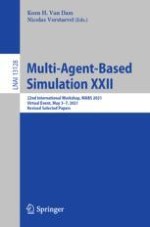2022 | OriginalPaper | Chapter
Using Agent-Based Modelling to Understand Advantageous Behaviours Against COVID-19 Transmission in the Built Environment
Authors : Arnaud Grignard, Tri Nguyen-Huu, Patrick Taillandier, Luis Alonso, Nicolas Ayoub, Markus Elkatsha, Gamaliel Palomo, Monica Gomez, Mario Siller, Mayra Gamboa, Carlos Ivan Moreno, Kent Larson
Published in: Multi-Agent-Based Simulation XXII
Publisher: Springer International Publishing
Activate our intelligent search to find suitable subject content or patents.
Select sections of text to find matching patents with Artificial Intelligence. powered by
Select sections of text to find additional relevant content using AI-assisted search. powered by
